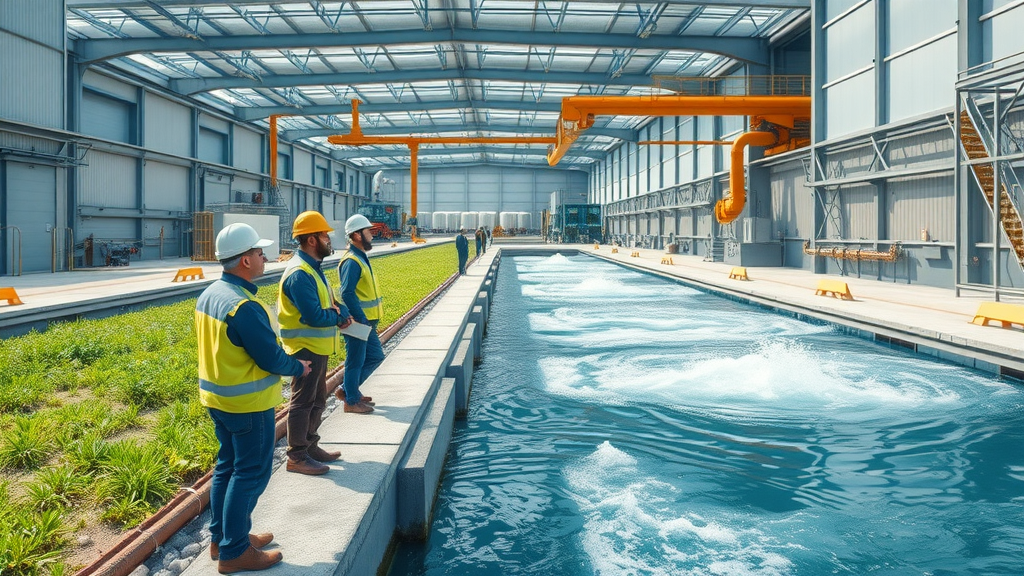Startling Fact: Did you know that exceeding permissible industrial wastewater discharge limits can lead not only to hefty fines but even forced shutdowns of your facility? For plant managers and Environmental Health & Safety (EHS) professionals in California, staying ahead of these requirements is critical to avoid costly penalties and disruptions.
Industrial wastewater compliance is more than a regulatory formality—it's an essential practice to protect water systems and secure your business's future. This article will guide you through the key parameters you must monitor, the regulatory framework governing these standards, and actionable steps to maintain compliance. With expert insights from Steve Manii of CSI Environmental, Inc., you'll learn how to proactively address common violations and safeguard your operations.
Startling Facts About Industrial Wastewater Compliance and Its Importance
Industrial wastewater compliance ensures that industries discharge treated water within legally prescribed limits, protecting public health and ecosystems. Violations of these limits, such as excess sulfides, TSS, COD, BOD, or improper pH levels, can trigger regulatory scrutiny and financial consequences.
Many facilities underestimate their risk, but in regions like Los Angeles and Riverside counties, authorities enforce some of the strictest wastewater discharge limits in the U.S. These local standards build on federal mandates under the Clean Water Act to curb pollution. Companies often receive notices following monthly sampling campaigns, and failure to act swiftly can lead to escalating penalties or even forced plant shutdowns. The stakes emphasize why understanding and maintaining industrial wastewater compliance is paramount to operational continuity.

Industrial complex engaged in wastewater treatment, illustrating the importance of strict industrial wastewater compliance.
Overview of Industrial Wastewater Compliance and Regulatory Framework
Definition of Industrial Wastewater and Its Impact on Water Systems
Industrial wastewater is the liquid waste generated from industrial processes that may contain harmful pollutants such as chemicals, oils, solids, and biological contaminants. When discharged untreated or improperly treated, it can severely impact surface and groundwater quality, harming aquatic life and posing risks to human health.
Given its potential hazards, industrial wastewater is subject to rigorous monitoring and control to prevent contamination of water systems. Compliance with discharge standards is necessary to protect ecosystems and meet environmental protection goals established at federal and local levels.
Federal and Local Effluent Guidelines Governing Wastewater Discharge
The Clean Water Act (CWA) provides the federal baseline for wastewater management in the U.S., setting effluent guidelines that all industries must follow. However, local authorities, such as counties and sanitation districts, can impose stricter limits tailored to their water system’s sensitivity.
Steve Manii of CSI Environmental explains, "The Clean Water Act sets the federal baseline, but counties like LA and Riverside can impose stricter discharge limits to protect their water systems."
This tiered approach means industries must understand both national and local regulations to ensure compliance throughout their operational footprint, with local agencies often performing monthly 24-hour composite samples to monitor discharge quality.
Key Parameters to Monitor for Industrial Wastewater Compliance
Fats, Oils, and Grease (FOG) and Their Effect on Wastewater Discharge
Fats, oils, and grease (FOG) are a common contaminant in industrial wastewater, especially from food processing and manufacturing. Excessive FOG can clog pipes and interfere with treatment processes, leading to increased pollutant levels and non-compliance.
Monitoring FOG levels is vital because high concentrations can lead to violations of discharge permits. Facilities need effective grease traps and regular maintenance to capture and reduce FOG accumulation before discharge.
Chemical Oxygen Demand (COD), Biochemical Oxygen Demand (BOD), and Total Suspended Solids (TSS)
Chemical Oxygen Demand (COD) and Biochemical Oxygen Demand (BOD) measure the amount of oxygen required to break down organic substances in wastewater. Elevated COD and BOD levels indicate high organic pollution, which strains natural water bodies’ oxygen and harms aquatic life.
Total Suspended Solids (TSS) refers to particles suspended in the water that can clog waterways and inhibit light penetration. Excessive TSS can violate local discharge limits and cause sedimentation issues downstream.
Facilities must monitor and treat COD, BOD, and TSS diligently to meet permit requirements and preserve water quality.
pH Levels and Their Role in Maintaining Compliance with Discharge Standards
Maintaining wastewater within the appropriate pH range — typically between 6 and 10 depending on local regulations — is crucial for compliance. Wastewater that is too acidic or alkaline can damage aquatic habitats and corrode infrastructure.
Regular pH monitoring allows facilities to adjust chemical treatments to neutralize their discharge and remain within required parameters, ensuring regulatory compliance and environmental safety.

Automated monitoring systems at an industrial wastewater treatment plant help maintain compliance with key discharge parameters.
The Compliance Notification Process: From Sampling to Action Plans
How Composite Sampling and Grab Samples Trigger Compliance Reviews
Industrial wastewater compliance monitoring typically begins with composite sampling—a 24-hour collected sample, or grab samples collected at specific times. These samples provide a snapshot of the effluent quality against permit limits.
If sample analyses show parameters exceeding permissible levels, regulatory agencies initiate compliance reviews. Monthly sampling frequency means facilities must consistently meet standards to avoid notifications.

Accurate sample collection is vital for determining compliance in industrial wastewater discharge.
Receiving and Responding to Written Warnings from Regulatory Agencies
When non-compliance occurs, the regulatory body issues a written warning stating the specific violation and requiring an action plan to resolve and prevent recurrence. This may include explanations for abnormal events like deep cleaning that caused temporary spikes.
According to Steve Manii, "When a compliance issue arises, the regulatory agency sends a written warning detailing the violation and requests an action plan to resolve and prevent future occurrences."
Facilities must respond by implementing corrective actions and conducting retests to demonstrate remediation. Failure to comply escalates enforcement efforts.
Common Causes of Non-Compliance and Effective Treatment Solutions
Addressing Sulfide Issues with Chemical Oxidizers like Chlorine and Hydrogen Peroxide
One frequent cause of violations is elevated sulfide levels, often caused by sediment disturbance during maintenance activities. Sulfides produce odors and are regulated strictly by permits.
Effective treatment involves chemical oxidizers such as injection of 12.5% chlorine or hydrogen peroxide into effluent lines before discharge. These oxidizers neutralize sulfides, helping facilities meet strict local standards.
Equipment and Process Upgrades to Reduce TSS, COD, and BOD Levels
Industrial facilities often upgrade or install treatment equipment like sedimentation tanks, clarifiers, and filtration systems to reduce TSS, COD, and BOD. Treatment depends on pollutant type; soluble organic compounds may require biological treatment with enzymes or microbes.
Implementing these solutions not only ensures compliance but can also result in significant cost savings by reducing fees charged based on discharge pollutant loads.

Precise chemical injection systems play a crucial role in controlling sulfides and other contaminants in industrial wastewater discharge.
Roles and Responsibilities: Who Handles Industrial Wastewater Compliance?
Environmental Health and Safety Managers, Maintenance Teams, and Plant Managers
Responsibility for industrial wastewater compliance often falls on designated personnel named on the discharge permit. These typically include Environmental Health and Safety (EHS) Managers, maintenance supervisors, and plant managers.
Each plays a vital role: EHS staff oversee regulatory aspects, maintenance ensure equipment functionality, and plant managers supervise overall operations. Clear communication and coordination between these roles are essential for timely response to compliance issues.

Collaboration among EHS managers, maintenance, and plant managers is key to effective wastewater compliance management.
Consequences of Non-Compliance with Industrial Wastewater Discharge Limits
Escalating Warnings, Fines, and Potential Plant Shutdowns
Initial non-compliance results in written warnings and requests for corrective action. If ignored, follow-up tests with continued violations trigger stricter enforcement including fines and possible suspension of discharge permits.
In severe cases, regulators can order plant shutdowns until compliance is demonstrated, compromising production and incurring substantial costs.
Public Disclosure of Non-Compliance and Its Impact on Business Reputation
Several counties publish lists naming facilities out of compliance, which can damage corporate reputation and customer trust. Public disclosure pressures companies to prioritize compliance not only to avoid fines but also to protect their brand.
Animated explainer video illustrating the industrial wastewater compliance process from generation to corrective actions.
Expert Insights: How CSI Environmental Supports Compliance and Treatment
Steve Manii of CSI Environmental states, "We act as a third-party liaison, helping businesses understand their compliance issues and offering cost-effective solutions to meet discharge standards."
Initial Consultation and Review of Lab Reports and Regulatory Notices
CSI Environmental begins with a brief phone consultation to understand your compliance challenges. They request recent lab reports and regulatory notices to assess your situation deeply before meeting onsite.
This preparation enables them to provide tailored recommendations and identify potential equipment or process improvements to achieve compliance.
Customized Action Plans and Equipment Recommendations for Compliance
Based on the assessment, CSI Environmental develops customized action plans. These may include chemical treatments like chlorine injection for sulfides or installation of filtration equipment to lower TSS, COD, and BOD levels.
Their expertise extends to acting as a liaison with regulatory agencies, easing communication and expediting resolution of compliance issues.
What You'll Learn: Key Takeaways on Industrial Wastewater Compliance
Understanding federal and local effluent guidelines
Identifying critical wastewater parameters to monitor
Navigating the compliance notification and response process
Implementing effective treatment solutions for common violations
Recognizing roles responsible for compliance management
Consequences of non-compliance and how to avoid them
Leveraging expert support from CSI Environmental
People Also Ask (FAQs) About Industrial Wastewater Compliance
What is wastewater compliance?
Wastewater compliance refers to meeting regulatory standards for the discharge of treated water from industrial or municipal sources to protect the environment and public health.
What is the definition of industrial wastewater?
Industrial wastewater is effluent generated from industrial processes that may contain pollutants such as chemicals, oils, solids, and biological materials requiring treatment before discharge.
What are the three major safety concerns in the wastewater treatment industry?
Major concerns include exposure to hazardous chemicals, biological pathogens, and physical hazards such as moving machinery or confined spaces in treatment facilities.
What law allowed the EPA to establish wastewater standards?
The Clean Water Act (CWA), enacted in 1972, empowered the EPA to establish and enforce wastewater discharge standards to safeguard water quality nationwide.
Conclusion: Ensuring Ongoing Industrial Wastewater Compliance
Proactive Monitoring and Timely Response to Regulatory Notices
Maintaining strict monitoring and swiftly addressing compliance notices protects your facility from fines, shutdowns, and reputation harm.
Partnering with Experts to Achieve Sustainable Compliance
Engaging experts like CSI Environmental offers tailored solutions and eases regulatory interactions, ensuring your business remains compliant and sustainable.
Steve Manii concludes, "Staying ahead of compliance issues not only protects the environment but also safeguards your business from costly penalties and reputational damage."
Get Your FREE Compliance Assessment Today
Call (800) 690-2436 to schedule your personalized consultation
To deepen your understanding of industrial wastewater compliance, consider exploring the following authoritative resources:
The U.S. Environmental Protection Agency’s (EPA) “Industrial Wastewater” page provides comprehensive information on the National Pollutant Discharge Elimination System (NPDES) permitting program, which sets discharge limits and conditions for industrial and commercial sources to protect water quality. (epa.gov)
The EPA’s “Industrial Effluent Guidelines” page outlines national standards for industrial wastewater discharges, detailing technology-based requirements for various industrial categories to ensure compliance with the Clean Water Act. (epa.gov)
These resources offer valuable insights into regulatory frameworks and best practices essential for maintaining compliance in industrial wastewater management.
 Add Row
Add Row  Add
Add 




Write A Comment